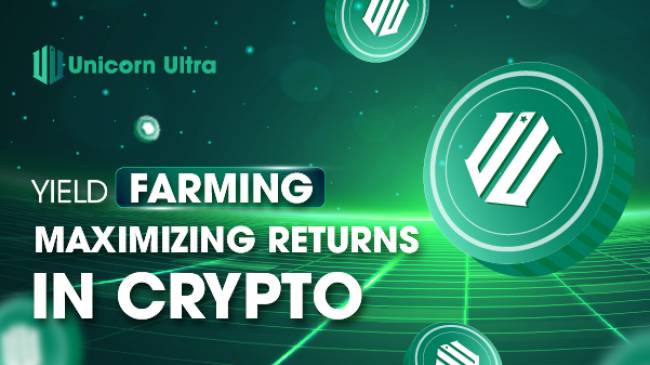The world of cryptocurrency is constantly evolving, offering innovative ways to generate passive income. One such method that has gained significant popularity is yield farming. What is Yield Farming? In this blog post, we will explore the fascinating realm of yield farming, its underlying principles, various types, associated benefits, risks involved, and provide a comprehensive guide on how to start your own yield farming journey.
Table of Contents
- What is yield farming?
- How does yield farming work?
- Common types of yield farming
- The benefits and risks of yield farming
- How to Start Yield Farming?
- Who is Yield farming beneficial for?
- What knowledge and skills are required to participate in yield farming?
- How to manage risks when participating in yield farming?
What is yield farming?

What is Yield farming? Yield farming, also known as liquidity mining, is a decentralized finance (DeFi) strategy that enables cryptocurrency holders to earn passive income by staking or lending their digital assets on DeFi platforms. It involves providing liquidity to the market by locking up funds in smart contracts in exchange for rewards.
How does yield farming work?
Yield farming operates on the principle of utilizing decentralized platforms and protocols to maximize returns on invested assets. Participants lock their crypto assets in smart contracts known as liquidity pools, which facilitate various lending, borrowing, and trading activities. By contributing to these pools, users become liquidity providers and earn rewards in the form of additional tokens or fees generated by the platform.
Common types of yield farming
There are several types of yield farming strategies, each with its unique characteristics and potential returns. Some common types include:
- Liquidity Pool Provision: Participants provide liquidity to decentralized exchanges (DEXs) by depositing pairs of tokens into liquidity pools. They earn rewards based on the trading fees generated by the DEX.
- Staking: Users lock their tokens in a particular protocol, such as a governance token, and receive rewards for securing the network and participating in decision-making processes.
- Lending and Borrowing: Participants lend their assets to borrowers on decentralized lending platforms and earn interest on their loaned funds.
The benefits and risks of yield farming
Yield farming offers several enticing benefits, including the potential for high returns, passive income generation, and the opportunity to participate in the DeFi ecosystem. However, it is essential to consider the risks involved, such as impermanent loss, smart contract vulnerabilities, market volatility, and potential token price depreciation.

How to Start Yield Farming?
To embark on your yield farming journey, follow these steps:
- Research and Select a Platform: Explore various DeFi platforms, and assess their security, reputation, and available farming opportunities.
- Choose the Right Assets: Select the digital assets you wish to stake or lend based on their potential returns, risk factors, and compatibility with the chosen platform.
- Set up a Wallet: Obtain a compatible cryptocurrency wallet, such as a MetaMask wallet, to securely store your assets and interact with decentralized platforms.
- Calculate Risks and Rewards: Evaluate the risks associated with different yield farming strategies, including impermanent loss, smart contract risks, and overall market conditions. Consider potential rewards and estimated returns.
- Start Farming: Connect your wallet to the chosen platform, deposit your assets into the selected liquidity pools, and monitor your farming activities regularly.
Who is Yield farming beneficial for?
Yield farming in the DeFi (Decentralized Finance) ecosystem can be beneficial for various participants, each with their unique objectives and goals. Here are the main groups of participants who can benefit from yield farming:
-
Liquidity Providers: Liquidity providers (LPs) are individuals who contribute funds to liquidity pools on decentralized platforms. They benefit from yield farming by earning rewards in the form of trading fees, governance tokens, or other incentives offered by the protocol. Yield farming allows LPs to put their idle assets to work and generate passive income.
-
DeFi Users: DeFi users, such as borrowers and traders, benefit indirectly from yield farming. The increased liquidity in DeFi platforms, thanks to yield farming, allows for more efficient trading and access to a wide range of financial services without relying on traditional intermediaries like banks.
-
Governance Participants: Some DeFi protocols offer governance tokens to liquidity providers. Holding these tokens gives LPs voting rights in the protocol's governance, allowing them to influence decisions related to upgrades, fee structures, and other changes. Yield farming incentivizes active participation in protocol governance.
-
Protocol Developers and Teams: Yield farming can be beneficial for DeFi protocol developers and teams. By offering governance tokens or other incentives to liquidity providers, they can attract more funds and activity to their platforms, leading to increased adoption and visibility.
-
Crypto Enthusiasts and Investors: Yield farming can be an attractive option for crypto enthusiasts and investors seeking to generate additional returns on their cryptocurrency holdings. By participating in yield farming, they can earn rewards and potentially outperform traditional investment options.
-
Long-Term Supporters: Yield farming can encourage long-term support for a DeFi protocol. Participants who provide liquidity for an extended period may receive better rewards or additional benefits, fostering loyalty to the platform.
-
Ecosystem Growth: Yield farming contributes to the overall growth and expansion of the DeFi ecosystem. As more funds are channeled into liquidity pools, it increases the market depth, making DeFi platforms more robust and attractive to users.
It's important to note that while yield farming offers opportunities for potential rewards, it also carries risks. Impermanent loss, smart contract vulnerabilities, and price volatility are some of the risks associated with yield farming. Participants should exercise caution, conduct thorough research, and consider their risk tolerance before engaging in yield farming activities.
Moreover, regulatory considerations and tax implications vary by jurisdiction, and participants should be aware of the legal aspects of their yield farming activities. As the DeFi space evolves, it's essential for participants to stay informed about new opportunities and potential risks.
What knowledge and skills are required to participate in yield farming?
Participating in yield farming in the DeFi (Decentralized Finance) space requires a certain level of knowledge and skills to navigate the complexities of the ecosystem and manage potential risks effectively. Here are the essential knowledge and skills required to engage in yield farming:
- Understanding of Blockchain and DeFi: A foundational understanding of blockchain technology, cryptocurrencies, and DeFi concepts is crucial. Familiarize yourself with terms like smart contracts, decentralized exchanges (DEXs), liquidity pools, and yield farming protocols.
- Wallet Management: Knowledge of cryptocurrency wallets, especially non-custodial wallets like MetaMask, is essential. Understand how to create and secure wallets, manage private keys, and interact with decentralized applications (DApps).
- Decentralized Exchanges (DEXs): Know how to use decentralized exchanges to trade, provide liquidity, and stake tokens. Understand the differences between different DEX platforms and their respective interfaces.
- Risk Management: Yield farming involves risks, such as smart contract vulnerabilities, impermanent loss, and market volatility. Learn how to assess and manage these risks, and only invest funds you can afford to lose.
- Liquidity Pools and LP Tokens: Understand how liquidity pools work and how to provide liquidity to earn LP (Liquidity Provider) tokens. Know how to stake these tokens to participate in yield farming rewards.
- Yield Farming Protocols: Research different yield farming protocols, including their tokenomics, rewards distribution mechanisms, and associated risks. Stay updated with any changes or upgrades to these protocols.
- Transaction Fees and Gas Optimization: Familiarize yourself with Ethereum gas fees and ways to optimize transactions to minimize costs. High gas fees can significantly impact yield farming profitability.
- Security Best Practices: Learn best practices for securing your assets and private keys. Be cautious of phishing attacks, rug pulls, and other scams prevalent in the DeFi space.
- Financial Analysis: Understand the factors influencing token prices, market trends, and the impact of reward distribution on potential returns. Conduct financial analysis to assess the feasibility of yield farming opportunities.
- Consensus Mechanisms: Some yield farming protocols require participation in consensus mechanisms like Proof-of-Stake (PoS) or Proof-of-Work (PoW). Familiarize yourself with these mechanisms if relevant.
- Tokenomics and Governance: Explore the tokenomics of DeFi projects and the role of governance tokens. Understand how governance mechanisms work and how you can participate in protocol governance.
- Staying Updated: The DeFi space is rapidly evolving, with new protocols and opportunities emerging regularly. Stay informed through reputable sources, forums, social media, and community discussions.
As a participant in yield farming, continuous learning is essential. Be prepared to adapt to changes in the DeFi landscape and stay vigilant against potential risks. Consider starting with smaller investments to gain experience before committing significant funds to yield farming activities. Moreover, be aware of the regulatory environment in your jurisdiction and ensure compliance with applicable laws and regulations. Seeking advice from experienced yield farmers or financial advisors can also provide valuable insights and guidance.

How to manage risks when participating in yield farming?
Managing risks effectively is crucial when participating in yield farming, as the DeFi (Decentralized Finance) space can be highly volatile and subject to various potential risks. Here are some strategies to manage risks when engaging in yield farming:
- Start with Small Amounts: Begin with small investments to test the waters and gain experience with yield farming protocols. Avoid investing more than you can afford to lose, especially when you are still learning about the risks involved.
- Diversify Across Protocols: Avoid concentrating all your funds in a single yield farming protocol. Diversify your investments across multiple protocols to reduce the impact of potential losses from one protocol on your entire portfolio.
- Research and Due Diligence: Conduct thorough research on the yield farming protocols you are considering. Understand their tokenomics, smart contract security audits, historical performance, and any
- Understand Impermanent Loss: Impermanent loss is a risk specific to liquidity provision in Automated Market Makers (
- Assess Smart Contract Security: Look for protocols that have undergone multiple security audits from reputable firms. Choose protocols with a proven track record of safe operations and those that have bug bounties to incentivize security researchers.
- Monitor Your Investments: Regularly check your yield farming positions and rewards. Stay vigilant for any abnormal activity or changes in the protocol's behavior.
- Stay Informed: Keep yourself updated with the latest developments, news, and potential risks in the DeFi space. Follow reputable sources and community discussions to stay informed about any changes in the protocols you are using.
- Risk Management Tools: Some DeFi platforms offer risk management features, such as insurance funds or hedging options. Utilize these tools when available to protect your investments from unforeseen events.
- Consider Staking Stablecoins: Staking stablecoins in yield farming can reduce exposure to volatile asset prices. However, be mindful of the risks associated with the underlying protocols and the potential for lower returns compared to riskier assets.
- Test with Testnet or Small Amounts: Before committing significant funds, test yield farming protocols on testnets or with small amounts of real funds. This allows you to understand how the protocol works and identify any potential issues without substantial risk.
- Evaluate Exit Strategies: Have a clear exit plan in case you need to withdraw your funds quickly. Be prepared to act swiftly if you notice any signs of potential risks or vulnerabilities.
- Use Stop-Loss Orders: In some cases, platforms may offer the option to set stop-loss orders. Utilize this feature to automatically exit a position if the price of an asset drops below a certain threshold, limiting potential losses.
Remember that yield farming is not risk-free, and there are no guarantees of profits. Always exercise caution, stay patient, and be prepared for both positive and negative outcomes. If you are uncertain about a specific protocol or investment strategy, seek advice from experienced DeFi users or financial advisors before making any decisions.
What is Yield Farming? Yield farming has emerged as an exciting and potentially lucrative opportunity within the world of decentralized finance. By understanding the fundamentals, exploring different strategies, and carefully managing risks, individuals can take advantage of yield farming to maximize their returns and actively participate in the vibrant DeFi ecosystem. However, it is crucial to approach yield farming with caution, conduct thorough research, and stay informed about market trends and developments. Follow https://uniultra.xyz/ for more blockchain updates.






